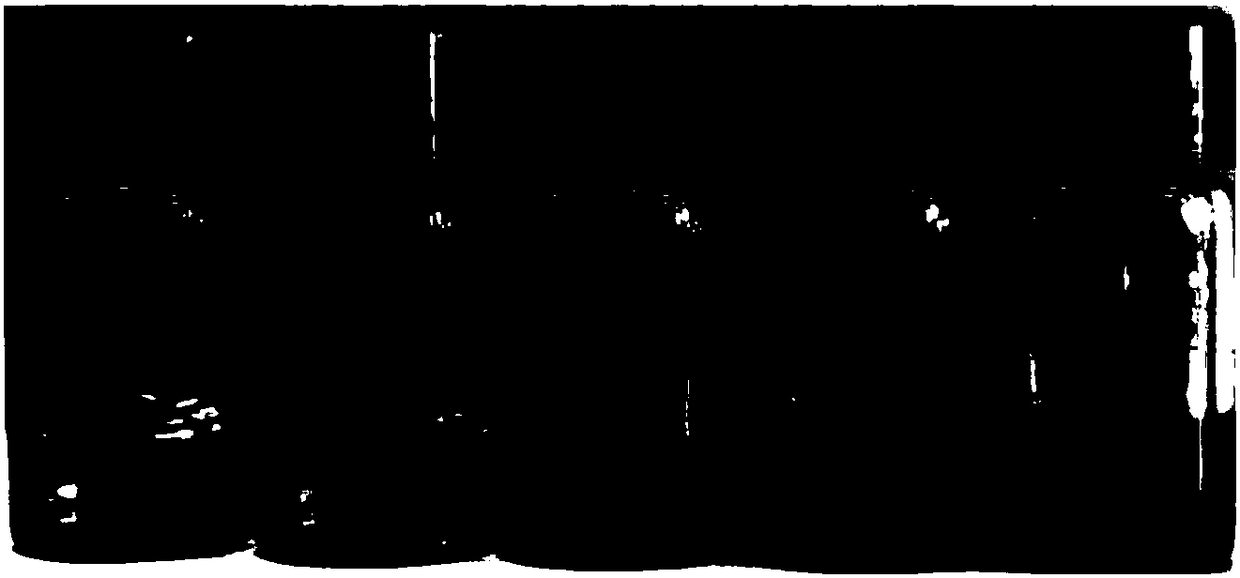Application of rhodium sheet nano enzyme in simulation of enzymatic catalysis
A nano-enzyme and biological enzyme technology, applied in the field of nano-enzymes, can solve the problems of single catalytic function, poor activity and insufficient catalytic efficiency, and achieve the effect of expanding the application range and widening the pH value and temperature range.
- Summary
- Abstract
- Description
- Claims
- Application Information
AI Technical Summary
Problems solved by technology
Method used
Image
Examples
Embodiment 1
[0057] Take acetic acid-sodium acetate buffer (pH=4), add the prepared rhodium flake dispersion and TMB solution, so that the concentrations of rhodium flakes and TMB in the system are respectively 3.75 μg mL -1 and 0.5mM, shake well, and leave it open at room temperature for 10 minutes; then observe the color change of the system, and scan the 325-800nm ultraviolet-visible spectrum.
[0058] figure 1 The result shows that the system is colorless when the rhodium sheet dispersion is not added, and after adding the rhodium sheet dispersion, the system turns blue, and the ultraviolet-visible spectrum results are as follows: figure 2 Shown; It shows that rhodium sheet can imitate oxidase to catalyze oxygen oxidation of TMB, and has similar oxidase activity.
Embodiment 2
[0060] Take acetic acid-sodium acetate buffer solution (pH=4), add rhodium flake dispersion, TMB solution and hydrogen peroxide solution, so that the concentrations of rhodium flakes, TMB and hydrogen peroxide in the system are respectively 1 μg mL -1 , 0.5mM and 0.5mM, shake well, and place at room temperature for 10 minutes; then observe the color change of the system, and scan the 325-800nm ultraviolet-visible spectrum.
[0061] figure 1 The result shows that the system is colorless when the rhodium sheet dispersion is not added, and after adding the rhodium sheet dispersion, the system turns blue; the ultraviolet-visible spectrum results are as follows figure 2 As shown, compared with the results of Example 1, the absorption value at 652nm is significantly increased, indicating that the rhodium sheet can simulate peroxidase to catalyze the oxidation of TMB by hydrogen peroxide, and has a similar peroxidase activity.
[0062] figure 1 The results also showed that rhodi...
Embodiment 3
[0064] Take PBS (pH=7), add xanthine solution, NBT solution, then add a certain amount of pre-concentrated rhodium sheet dispersion and xanthine oxidase solution, so that the concentrations of xanthine, NBT and xanthine oxidase are respectively 0.4mM , 0.4mM and 0.125U·mL -1 . In addition, a control experiment without adding rhodium plate dispersion was performed. At room temperature and in the air, when the superoxide radical produced by the xanthine / xanthine oxidase system reduces NBT, the solution turns from yellow to blue, and the maximum absorption peak appears at 560nm.
[0065] Measure the absorbance of the reaction mixture at 560nm, find out the linear relationship between the change value of the absorbance per minute and the reaction time, and determine the optimal reaction time. Finally, within the optimal reaction time, calculate the change of the absorbance of the reaction mixture before and after adding the rhodium flakes of various concentrations, and obtain th...
PUM
 Login to View More
Login to View More Abstract
Description
Claims
Application Information
 Login to View More
Login to View More - R&D
- Intellectual Property
- Life Sciences
- Materials
- Tech Scout
- Unparalleled Data Quality
- Higher Quality Content
- 60% Fewer Hallucinations
Browse by: Latest US Patents, China's latest patents, Technical Efficacy Thesaurus, Application Domain, Technology Topic, Popular Technical Reports.
© 2025 PatSnap. All rights reserved.Legal|Privacy policy|Modern Slavery Act Transparency Statement|Sitemap|About US| Contact US: help@patsnap.com



